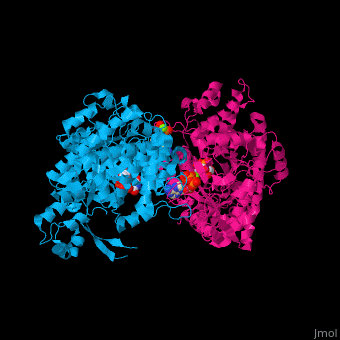Function
Ribonucleotide reductase (RNR) or ribonucleotide-diphosphate reductase catalyzes the formation of deoxyribonucleotides from ribonucleotides[1]. There are 3 classes of RNR.
- Class Ia RNR is a tetramer composed from large (RNR1) and small (RNR2) subunits. Class I RNR is iron-dependent and produces tyrosyl radical. Thimidine triphosphate (TTP) is an effector in the reaction[2].
- Class Ib RNR contains 2 proteins: α (NrdE) and β (NrdF)[3].
E. Coli contains two types of RNR: the aerobic RNR belongs to class Ia and is composed of proteins R1 and R2, the anaerobic RNR belongs to class Ib[4].
- Class II RNR reduces ribonucleotide triphosphates using coenzyme B12[5].
- Class III RNR generate glycine radical using S-adenosyl methionine and Fe-S center[6].
For details on human RNR2 see P53R2.
For mouse RNR see Mouse Ribonucleotide Reductase R2.
For RNR small subunit with nitrotyrosine modification see Nitrotyrosine.
See also Ribonucleotide Reductase.
Relevance
RNR inhibitors are studied as therapeutic antiviral, antibacterial and anti-cancer drugs[7].
Structural highlights
Class II RNR is . The active site which binds the substrate is in a tight pocket and contains conserved residues involved in the catalytic mechanism [8].
- . Water molecules are shown as red spheres.
- .
3D Structures of Ribonucleotide reductase
Ribonucleotide reductase 3D structures

